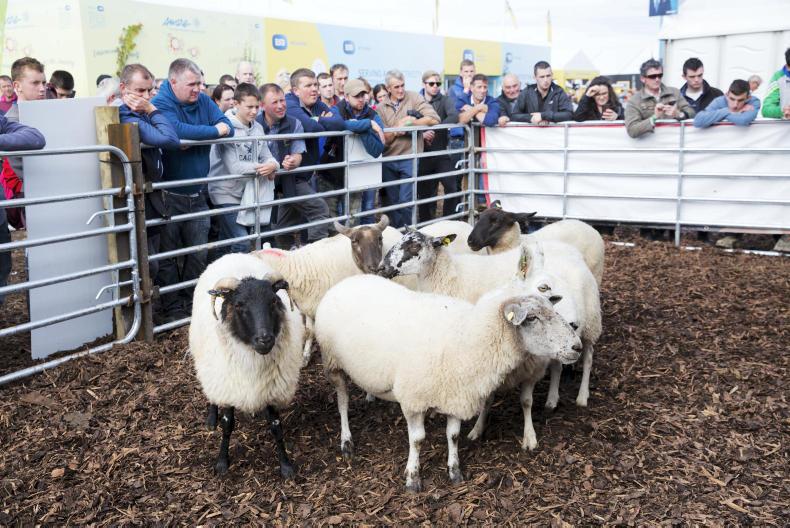The Sheep Welfare Scheme has been a regular feature in articles and management notes of late. Given the strong interest, it was decided to include it as one of the main discussion topics in the livestock demonstrations held in conjunction with Bord Bia and ICBF at this week’s National Ploughing Championships.
There have also been more clarifications and advice from the Department of Agriculture on the topic of mineral supplementation, with lots of questions arising in this area in previous weeks. The most recent question raised is if the manufacturer’s label guidelines listing treatment for ‘‘sheep’’ would suffice to cover ewes, or if ewes had to be specifically referred to in the label recommendations.
This question is timely given that farmers are starting to purchase minerals with many using the Ploughing to assess the options on offer. The Department has clarified that labels listing treatments and dosage rates for sheep (as intended for ewes) are eligible under the post-breeding mineral supplementation option.
Recapping on mineral supplementation requirements, the manufacturer’s guidelines must also state the dose rate and period of cover provided by the supplementation. Where there is a range in cover of two to three months for example, the lesser period of cover of two months is taken as the cover period. Minerals must be supplemented for at least 60 days post-breeding with the commencement date being the day rams are joined to ewes.
Supplementation can start in advance of breeding with farmers advised to ensure the supplementation programme selected is sufficient to cover the period pre-breeding and the following 60 days. For example, if a drench is administered that has a cover period of 60 days two weeks in advance of breeding, then repeat treatment is required day 46 post-breeding.
As listed last week a combination of products can be used – for example, a drench with a cover period of 30 days or a bolus that will not cover the full 60-day duration could be used at the outset with mineral buckets introduced to bridge the gap.
Farmers should put thought into the option that will best suit their flock with numerous options on the market from boluses that have a cover period of up to six months, injectable products, mineral buckets and an extensive range of products. In relation to purchasing mineral supplements, once the manufacturer of the product, the wholesaler or retailer is registered with the Department as a food business operator, the product will be considered eligible for the purposes of the Sheep Welfare Scheme.
Timely reminder
As the Sheep Welfare Scheme is currently in its first year, it is timely to remind applicants that they should complete their selected actions in accordance with the terms and conditions of the scheme and within the applicable timeframes. In particular, the Department is advising applicants who selected the action parasite control (faecal egg count) to note that, for lowland flocks, this action must be completed by 30 September. For hill flocks, this action must be completed in the first four weeks post -weaning. In each case, samples must be returned to one of the approved laboratories by the relevant deadline. A list of approved laboratories is available on the Department of Agriculture, Food and the Marine website www.agriculture.gov.ie.
It is also important that applicants are aware of the requirement to retain receipts/invoices and other documentary evidence as laid out in the terms and conditions of the scheme. These documents must be made available to the Department on request and it is important to submit them along with the Scheme Action Record Book when requested to do so by the Department. The receipts must be applicable to the timeframe they relate to. For example, receipts for mineral supplementation products must coincide with the flock’s breeding season. Where a split breeding pattern is used then this should be recorded in the record book.
Selecting profitable rams
Ram breeding sales are well advanced at this stage of the season but there will still be significant levels of activity in the coming weeks as the sales season draws to a close.
The breeding demonstration in conjunction with Sheep Ireland covered three main areas – selecting rams using physical attributes and €uro-star evaluations, using a team of rams to improve accuracy levels and reduce the risk of €uro-Star values fluctuating and the data quality index (DQI).
The two rams exhibited to explain €uro-Star values were from the pedigree flock of Edmond and Paul O’Gorman, Lisfunchon, Ballyporeen, Co Tipperary. The rams varied significantly in type and genetics with a five-star terminal ram and a five-star maternal ram.
Eamon Wall of Sheep Ireland told farmers at the demos to concentrate on the type of ram that best suits their flock paying particular attention to the key traits making up the evaluation.

The maternal ram on the left and terminal ram on the right.
Eamon said: “Farmers looking for terminally bred rams should concentrate on days to slaughter as this is a direct indication of growth rate. This ram has a value of -9.45 days to slaughter meaning that lambs will be ready for slaughter on average over nine days faster than the average ram, putting him in the top 1% of the breed. This contrasts with the maternally bred ram which has a days to slaughter figure of 2.14, but that is not the key trait of importance here. Lamb survivability is 0.737%, while the index for the number of lambs born is €0.997, which puts the maternal ram in the top 3%. This ram is also positive for its daughter milk index with a figure of €4.01.”
The accuracy levels of the two rams ranged from 43% to 46% on the terminal and replacement index. These levels are at the upper end for ram lambs and Eamon says that increasing accuracy levels is a challenge for the sector, but one that should improve as more data comes available.
“We would obviously like to be up at 80% to 90% accuracy but the reality is that the low level of recording is limiting upward movement. One of the most challenging aspects for breeders is €uro-Star figures fluctuating due to low accuracy as more information comes on stream. The effect of this can be limited by farmers using a team of rams. This is successfully used in the dairy sector to combat against low reliability. For example, using three rams instead of one will greatly reduce the risk.”
The DQI is a new concept used by Sheep Ireland to rate the level of information submitted in a flock. This strengthens the confidence farmers have in selecting rams with information collected on a range of aspects such as mating, scanning and lambing records, weight records and ultrasound scanning information for example.
Eamon said that a DQI of 80% to 100% is excellent and is the target for breeders to achieve.
Liver fluke is likely to be a significant issue this autumn and winter, given the high levels of rainfall since July and suitable temperatures for the liver fluke parasite to thrive. A frequent cause of mortality on farms is not the fact that sheep have not received treatment, rather that sheep have been treated with a product that is not suitable for the stage of the liver fluke causing the problem.
Acute liver fluke is the greatest killer of sheep in the period from October to January. Treating animals with a product that only kills mature fluke will do little to control the problem with a product required that at least targets and kills immature and mature fluke. Table 1 details the active ingredient of flukicides on the Irish market and the flukicide products with this ingredient range. It does not list combination and wormer products as these are not advised for blanket treatment of ewes due to the increased risk of resistance developing if ewes receive wormers where they are not required.
Correct dose rate
The Ploughing demos also discussed another area that is often responsible for incorrect treatment, which is an inadequate volume of product being administered. There are two causes for this – the weight of animals being underestimated and dosing guns delivering an incorrect volume and needing recalibration. The ewes at the Ploughing demo were a range of breeds with liveweight ranging from the heaviest Suffolk ewe weighing 80kg and reducing down to 62kg for the lightest animal included. It is therefore important for farmers to get an accurate assessment of weight and to reassess at a later stage when ewes are heavily pregnant.







 This is a subscriber-only article
This is a subscriber-only article












SHARING OPTIONS: